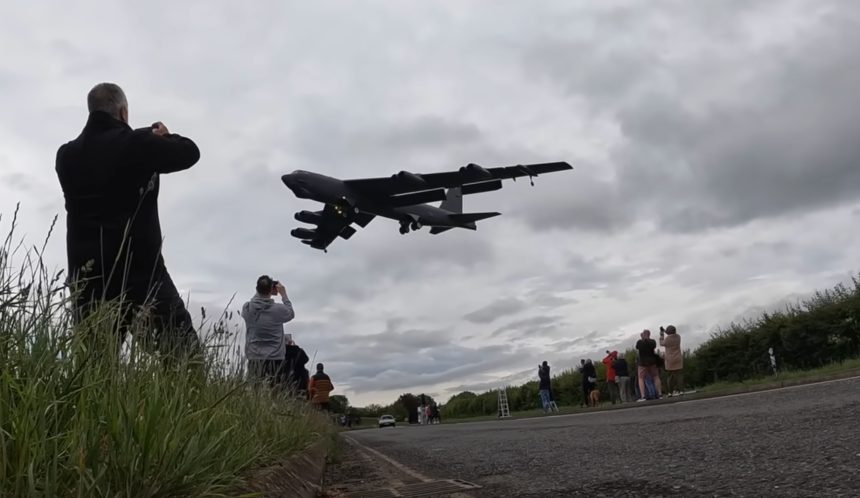Spectators thrill to the sight of B-52 bombers launching and recovering at RAF Fairford.
On Monday, May 20, 2024, two U.S. Air Force B-52 Stratofortress bombers from the 5th Bomb Wing at Minot Air Force Base, North Dakota, touched down at RAF Fairford in the U.K. for a routine bomber task force deployment.
Later in the week, two more B-52 bombers arrived, one on Wednesday and another on Thursday, bringing the total number of Stratofortress bombers assigned to the 69th Expeditionary Bomb Squadron, under Bomber Task Force Europe 24-3, to four.
As usual, U.S. Air Force personnel and aircraft of the BTF are working with NATO Allies and other international partners to synchronize capabilities and reinforce security commitments within the U.S. European Command’s area of responsibility. The B-52s have already conducted missions in the Baltics, Eastern Europe, and North Africa, similar to previous deployments.
Some of these missions could be tracked online using flight tracking websites.
A pair of B-52’s are up from RAF Fairford and tracking well this morning. Tuesday’s flight was a wave the flag day around Kaliningrad. pic.twitter.com/LbgYUKER4q
— MeNMyRC (@MeNMyRC1) May 31, 2024
USAF B-52 Stratofortress… pic.twitter.com/twFXaxuQ7V
— Jamming (@balticjam) May 28, 2024
One of the missions brought the bombers over North Africa for ex. African Lion 2024, during which the B-52s integrated with the RMAF (Royal Moroccan Air Force) aircraft.
Moroccan Royal Air Force fighter jets escort a US Air Force B-52H Stratofortress during Exercise African Lion 2024 over Morocco on May 31.
Images provided by Royal Moroccan Armed Forceshttps://t.co/mVF5fVN2achttps://t.co/KZTISVnlf3 pic.twitter.com/EEENpBRtX8
— Ryan Chan 陳家翹 (@ryankakiuchan) June 3, 2024
Spectators regularly gather outside RAF Fairford to watch the B-52 operations as they take off and land. The following outstanding footage shows what aviation enthusiasts can see spotting at the base located in Gloucestershire, half an hour north of Swindon, home of the world famous RIAT airshow.
We have already reported about the unusual event happened on May 20, when the first B-52H, airframe 61-0018, flying as GROAT 11 was on final for landing at RAF Fairford: the Stratofortress was configured for landing after a U-2 had just landed and was still on the runway.
The B-52 performed a go-around and landed a few minutes later, a scene caught on camera in the video that we posted here.
These BTF deployments regularly demonstrate the U.S. commitment to NATO Allies and partners through deterrence missions, often integrating with allied assets.
BTF 24-3 is also part of the Large Scale Global Exercise 2024, a comprehensive initiative that links military operations across various combatant commands. LSGE24 enables U.S. Joint Forces to train with Allies and partners, fostering shared understanding, trust, and interoperability in addressing global security challenges.
The Air Force might the B-52 until 2060
The BUFF (Big Ugly Fat Fellow) is about to undergo the largest modification program in its history. The U.S. Air Force plans to finalize integration activities and deliver the first lot of modified Stratofortress bomber, designated B-52J, in the 2026-2027 timeframe, with initial operational capability expected in 2030. Thanks to new RR F130 engines, selected in 2021 to replace the bomber’s Pratt & Whitney TF33-PW-103s used on the Stratofortress fleet since the 1960s, the Air Force will be able to fly the iconic bomber through at least 2050, possibly 2060, increasing fuel efficiency and range, reducing emissions in unburned hydrocarbons, and significantly reducing maintenance costs.
Another interesting upgrade to the B-52 is the new radar, a modified valiant of the F/A-18E/F Super Hornet’s APG-79 AESA radar. This will give the B-52s greatly improved radar range and situational awareness, while taking less space then the older mechanically scanned radar, thus leaving room for electronic warfare functions.
Thanks to the APG-79, the B-52s will feature greatly improved radar range and situational awareness along with the capability to slave the targeting pod to the radar and vice versa, for target acquisition and identification.
One major external difference is the presence of two large humps over the fuselage, near the wing roots. A Boeing spokesperson said the humps are not new and not part of their upgrade program, however, when pressed, hinted that they could host classified equipment. Based on shape and position, it is being reported that they could be associated with wideband satellite communications systems.
Externally, the B-52 will also have a cleaner look, as the blisters that currently house the AN/ASQ-151 Electro-Optical Viewing System (EVS) will be removed: the EVS was used to help crews fly safely at very low altitudes, but it was largely supplanted by the Litening and Sniper targeting pods installed on pylons under the bomber’s left wing.
Inside the cockpit, the BUFF is also getting an upgrade, with new MFDs (multifunction digital displays), hybrid mechanical-to-digital throttle system, new data concentrators units new engine fault maintenance recorder, new engine air data system and all the related updates in panels, consoles and wirings. It won’t be a full glass cockpit though, as some of the analogue instruments are going to remain. What’s also going to disappear is one of the crew member stations, as the total crew is reduced to four members, instead of the current five.
The mostly analog cockpit of the B-52H doesn’t make me feel too old after all. Love it. pic.twitter.com/06Bkg2c8QU
— David Cenciotti (@cencio4) May 28, 2024
Initially, the B-52J was supposed to be able to use the hypersonic AGM-183 Air-Launched Rapid Response Weapon (ARRW), the U.S. Air Force is planning to abandon the ARRW hypersonic weapon program after the last two test flights of the prototyping phase and focus instead on the Hypersonic Attack Cruise Missile (HACM).









